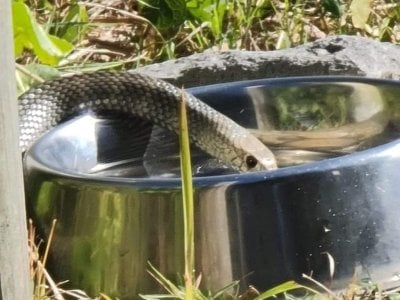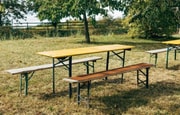Deadly danger at your local park! Snake spotted drinking from public dog bowl
- Replies 3
We all love taking our pups for a walk at the local park or bringing them to the beach, where we can play fetch with their favourite stick to their heart's content.
However, age-old wisdom (and now science!) has always shown that there is safety in numbers. This wisdom extends to nature too, especially when it comes to snakes.
Recently, there have been numerous reports of a venomous eastern brown snake dangerously inserting its head into public dog bowls.
On a beach in New South Wales, Rodney Cossor of WILD Conservation, witnessed the snake sipping from the bowl and skillfully captured the moment with his camera.
He shared the image with WILD Conservation, who promptly posted it on social media to update their readers.
In a Facebook post, the conservation group expressed their concern: ‘We were shown this photo by a worried resident today who also witnessed a snake drinking from her dog's bowl in Sydney. Just keep an eye out, as snakes are currently on the move.’
Mr Kane Durrant, Director and Principal Ecologist of WILD Conservation, highlighted the danger posed by eastern brown snakes, which are found across the eastern states from North Queensland to South Australia.
He highlighted these snakes as Australia's deadliest due to their highly toxic venom and close encounters with humans, resulting in roughly two deaths annually.
‘Generally, there’s on average about two deaths per year in Australia from snake bites … and eastern browns are responsible for the most deaths in Australia.’
In fact, Mr Durrant has been inundated with calls from worried residents, including one from a Sydney woman whose dog discovered a red-bellied black snake in her yard and another from a man who tragically found his dog dead in the garden upon returning from work.
Mr Durrant also clarified that snakes become more active during ‘Snake Season’, which typically starts in September and can continue until April.
Therefore, in preparation for summer, residents in snake-prone suburbs or those near golf courses, cemeteries, or creeks are advised to keep their backyards tidy and reduce the number of areas where snakes might seek cover.
‘They like dry grassy areas and there've been quite a few sightings of them by rivers or on the beach and in picnic grounds.’
‘They can also be seen near people’s fish ponds and water features in the yards, and sometimes that includes animal’s water bowls.’
In light of this, we strongly advise against approaching a snake if you happen to encounter one; instead, please move away from it. If you suspect that your pet has been bitten, it's crucial to seek prompt veterinary care for your beloved companion.
It's important to acknowledge that snakes, though unpredictable, are native creatures that play a vital role in our ecosystem. Show them respect by maintaining a safe distance and approaching them with caution for your own safety.

Members, what precautions have you taken to ensure your pets' safety from potential snake encounters in your area? Let us know in the comments below!
However, age-old wisdom (and now science!) has always shown that there is safety in numbers. This wisdom extends to nature too, especially when it comes to snakes.
Recently, there have been numerous reports of a venomous eastern brown snake dangerously inserting its head into public dog bowls.
On a beach in New South Wales, Rodney Cossor of WILD Conservation, witnessed the snake sipping from the bowl and skillfully captured the moment with his camera.
He shared the image with WILD Conservation, who promptly posted it on social media to update their readers.
In a Facebook post, the conservation group expressed their concern: ‘We were shown this photo by a worried resident today who also witnessed a snake drinking from her dog's bowl in Sydney. Just keep an eye out, as snakes are currently on the move.’
Mr Kane Durrant, Director and Principal Ecologist of WILD Conservation, highlighted the danger posed by eastern brown snakes, which are found across the eastern states from North Queensland to South Australia.
He highlighted these snakes as Australia's deadliest due to their highly toxic venom and close encounters with humans, resulting in roughly two deaths annually.
‘Generally, there’s on average about two deaths per year in Australia from snake bites … and eastern browns are responsible for the most deaths in Australia.’
In fact, Mr Durrant has been inundated with calls from worried residents, including one from a Sydney woman whose dog discovered a red-bellied black snake in her yard and another from a man who tragically found his dog dead in the garden upon returning from work.
Mr Durrant also clarified that snakes become more active during ‘Snake Season’, which typically starts in September and can continue until April.
Therefore, in preparation for summer, residents in snake-prone suburbs or those near golf courses, cemeteries, or creeks are advised to keep their backyards tidy and reduce the number of areas where snakes might seek cover.
‘They like dry grassy areas and there've been quite a few sightings of them by rivers or on the beach and in picnic grounds.’
‘They can also be seen near people’s fish ponds and water features in the yards, and sometimes that includes animal’s water bowls.’
In light of this, we strongly advise against approaching a snake if you happen to encounter one; instead, please move away from it. If you suspect that your pet has been bitten, it's crucial to seek prompt veterinary care for your beloved companion.
It's important to acknowledge that snakes, though unpredictable, are native creatures that play a vital role in our ecosystem. Show them respect by maintaining a safe distance and approaching them with caution for your own safety.
Key Takeaways
- A venomous eastern brown snake seen drinking from a public dog bowl serves as a warning to pet owners.
- Kane Durrant, WILD Conservation's Director and Principal Ecologist, highlighted the snakes' proximity to humans and their extremely toxic venom.
- Warmer weather has led to more snake sightings, with the eastern brown snake accounting for a third of reports.
- Pet owners should maintain tidy yards to minimise snake hiding spots and seek immediate veterinary care for suspected snake bites.
Members, what precautions have you taken to ensure your pets' safety from potential snake encounters in your area? Let us know in the comments below!









